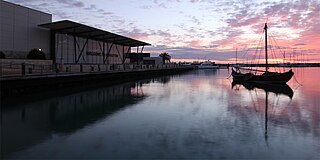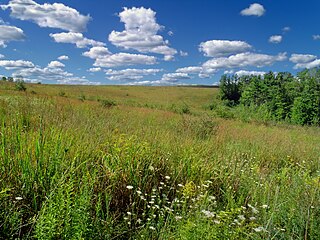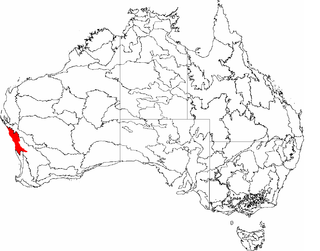
Caladenia flava, commonly known as cowslip orchid, is a species of orchid endemic to the south-west of Western Australia. It is a relatively common orchid with a single, hairy leaf and up to three yellow flowers which often have red markings. In 2001 three subspecies were named and a fourth is recognised but not as yet formally described.

Caladenia carnea, commonly known as pink fingers, is a plant in the orchid family Orchidaceae and is endemic to eastern and south-eastern Australia, including Tasmania. It has a single thin, green leaf and one to five white or pink flowers with red stripes and two rows of yellow-tipped "calli" on their labellum.
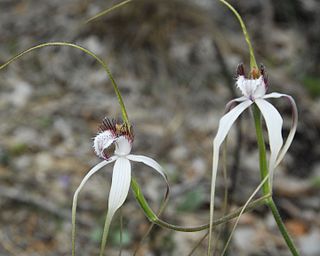
Caladenia longicauda is a species of plant in the orchid family Orchidaceae and is endemic to the south-west of Western Australia. It is distinguished by its large leaf and by its up to five large, white flowers which have drooping sepals and petals with long, thickish brown "tails".

Pheladenia deformis, commonly known as blue fairy orchid or blue beard is the only species of the flowering plant genus Pheladenia in the orchid family, Orchidaceae and is endemic to Australia. It was originally named as Caladenia deformis and has since had several name changes. Plants have a single, narrow, hairy leaf and usually blue flowers with relatively short, broad sepals and petals and an unusual labellum.

Caladenia latifolia, commonly known as pink fairies is a species of orchid endemic to Australia and is common and widespread in the southern half of the continent and in Tasmania. It has a single, hairy leaf and up to four pink flowers. It is easily distinguished by its relatively large, green leaf, and pink flowers on an unusually tall spike.

Caladenia gracilis, commonly known as musky caps or musky caladenia, is a plant in the orchid family Orchidaceae and is endemic to eastern and south-eastern Australia, including Tasmania. It is a ground orchid with a single leaf and up to six flowers which are dark-coloured on the back and white on the front, sometimes tinged with pink and with a strong musky or soapy odour. The species is also known as Caladenia moschata in Victoria.
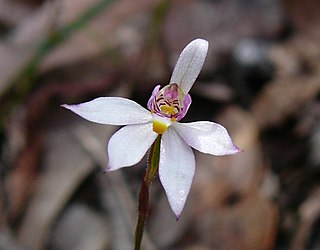
Caladenia alata, commonly known as the fairy orchid, is a plant in the orchid family Orchidaceae and is found in south-eastern Australia and New Zealand. It is a ground orchid with small, usually short-lived flowers, which have relatively stiffly held petals and sepals and reddish-purple bars on the labellum.

Caladenia attingens, commonly known as mantis orchids, are plants in the orchid family Orchidaceae and are endemic to the south-west of Western Australia. There are three subspecies, each of which has a single hairy leaf and one or two brightly coloured flowers with upswept sepals and a labellum with long, comb-like fringes. The subspecies differ in size, distribution and habitat.

Caladenia congesta, commonly known as black-tongue caladenia, is a plant in the orchid family Orchidaceae and is endemic to Australia. It is a ground orchid with a single, sparsely hairy leaf, and up to three bright pink flowers with the central part of the labellum completely covered with black calli. It is a widespread species but not common in any part of its range.

Caladenia denticulata subsp. denticulata, commonly known as the yellow spider orchid, is a plant in the orchid family Orchidaceae and is endemic to the south-west of Western Australia. It has a single erect, hairy leaf and one or two yellowish flowers which have a white labellum with pale red markings.
Caladenia denticulata subsp. rubella, commonly known as the clumped spider orchid, is a plant in the orchid family Orchidaceae and is endemic to the south-west of Western Australia. It has a single erect, hairy leaf and one or two dull or pinkish red flowers with prominent dull red markings and with a white labellum with red markings.

Caladenia filamentosa, commonly known as daddy-long-legs, is a plant in the orchid family Orchidaceae and is endemic to eastern Australia. It is a ground orchid with a single hairy leaf and up to four, usually dark red flowers with long, drooping lateral sepals and petals.

Caladenia flava subsp. flava, commonly known as the cowslip orchid, is a species of orchid endemic to the south-west of Western Australia. It is a relatively common orchid with a single, hairy leaf and up to three golden-yellow flowers which often have red markings.

Caladenia flava subsp. sylvestris, commonly known as the karri cowslip orchid, is a species of orchid endemic to the south-west of Western Australia. It has a single, hairy leaf and up to three pale yellow and cream-coloured flowers which are white near the tips of the sepals and petals and marked with bright red or pink.
Caladenia attingens subsp. effusa, commonly known as granite mantis orchid, is a subspecies of orchid endemic to the south-west of Western Australia. It has a single erect, hairy leaf and one or two green, yellow and red flowers. It differs from the other subspecies of Caladenia attingens in having smaller flowers with lateral sepals which are not upswept and a labellum which is less than 15 mm (0.6 in) wide.
Caladenia patersonii is a plant in the orchid family Orchidaceae and is native to Victoria and Tasmania. It is a ground orchid with a single hairy leaf and one or two creamy-white, yellowish or pink flowers.

Caladenia pendens subsp. talbotii, commonly known as Talbot's spider orchid, is a plant in the orchid family Orchidaceae and is endemic to the south-west of Western Australia. It has a single hairy leaf and one or two white, red and yellow flowers with long drooping petals and sepals and sometimes has a citrus-like scent.

Caladenia testacea, commonly known as honey caps, or honey caladenia is a plant in the orchid family Orchidaceae and is endemic to New South Wales. It is a ground orchid with a single, sparsely hairy leaf and up to three white to yellowish-green flowers with brownish tips and a darker back.
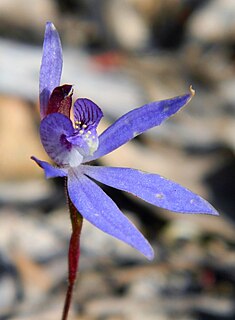
Caladenia caerulea, commonly known as the eastern tiny blue china orchid, blue caladenia or blue fairy is a plant in the orchid family Orchidaceae and is endemic to eastern Australia. It has a single narrow leaf and a single blue flower.

Microtis media subsp. media, commonly known as the common mignonette orchid, is a species of orchid which is endemic to the south–west of Western Australia. It is a common, widespread orchid with a single smooth, tubular leaf and a flowering spike with up to one hundred small green flowers. It differs from Microtis media subsp. densiflora in the shape of its flower spike and the shape of its labellum.



